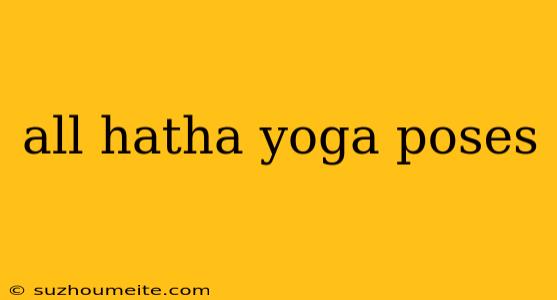All Hatha Yoga Poses: A Comprehensive Guide
Hatha yoga is a branch of yoga that focuses on physical postures (asanas) and breathing techniques (pranayama). It is often described as the foundation of many other yoga styles, including Ashtanga, Vinyasa, and Iyengar.
The term "Hatha" is derived from the Sanskrit words "ha" (sun) and "tha" (moon), representing the balance between the masculine and feminine energies within the body. This balance is achieved through the practice of Hatha yoga, which seeks to harmonize the physical, mental, and spiritual aspects of the practitioner.
This article will provide a comprehensive guide to all Hatha yoga poses, exploring their benefits, modifications, and contraindications. However, it's essential to consult a qualified yoga instructor for personalized guidance and proper alignment before attempting any of these poses.
Standing Poses
1. Mountain Pose (Tadasana):
- Benefits: Grounding, stability, promotes proper posture.
- Modifications: Place a block or cushion under the heels for support.
- Contraindications: None
2. Warrior I Pose (Virabhadrasana I):
- Benefits: Strengthens legs and arms, improves balance, opens chest and hips.
- Modifications: Use a chair or wall for balance support.
- Contraindications: Knee injuries, high blood pressure.
3. Warrior II Pose (Virabhadrasana II):
- Benefits: Strengthens legs, improves balance, opens hips and chest.
- Modifications: Use a block or cushion under the front hand for support.
- Contraindications: Knee injuries, high blood pressure.
4. Triangle Pose (Trikonasana):
- Benefits: Stretches hamstrings, calves, and spine, improves balance, opens hips.
- Modifications: Place a block or cushion under the hand for support.
- Contraindications: Low blood pressure, neck injuries.
5. Half Moon Pose (Ardha Chandrasana):
- Benefits: Strengthens legs and core, improves balance, opens hips.
- Modifications: Use a chair or wall for balance support.
- Contraindications: Knee injuries, wrist injuries.
6. Tree Pose (Vrksasana):
- Benefits: Improves balance, strengthens legs, opens hips.
- Modifications: Place a block or cushion under the foot for support.
- Contraindications: Ankle injuries, dizziness.
7. Downward-Facing Dog (Adho Mukha Svanasana):
- Benefits: Stretches hamstrings, calves, and spine, strengthens arms and shoulders.
- Modifications: Bend knees slightly for less pressure on the hamstrings.
- Contraindications: Wrist injuries, high blood pressure.
Seated Poses
1. Easy Pose (Sukhasana):
- Benefits: Calming, relaxing, promotes focus.
- Modifications: Use a cushion for support under the hips.
- Contraindications: None
2. Cross-legged Pose (Sukhasana):
- Benefits: Calming, relaxing, promotes focus.
- Modifications: Use a cushion for support under the hips.
- Contraindications: None
3. Staff Pose (Dandasana):
- Benefits: Strengthens spine, improves posture, calms the mind.
- Modifications: Place a blanket under the hips for support.
- Contraindications: Back injuries, hamstrings tightness.
4. Seated Forward Bend (Paschimottanasana):
- Benefits: Stretches hamstrings, calves, and spine, calms the mind.
- Modifications: Use a strap or blanket to reach the feet.
- Contraindications: Back injuries, hamstrings tightness.
5. Spinal Twist (Parivrtta Sukhasana):
- Benefits: Stretches spine, improves digestion, relieves stress.
- Modifications: Use a cushion for support.
- Contraindications: Back injuries, neck injuries.
Lying Poses
1. Child's Pose (Balasana):
- Benefits: Calming, relaxing, stretches back and hips.
- Modifications: Place a cushion under the forehead for support.
- Contraindications: None
2. Corpse Pose (Savasana):
- Benefits: Deep relaxation, promotes calmness and awareness.
- Modifications: Place a blanket over the body for warmth.
- Contraindications: None
3. Bridge Pose (Setu Bandhasana):
- Benefits: Strengthens back, opens chest, stretches neck.
- Modifications: Place a block or cushion under the sacrum for support.
- Contraindications: Neck injuries, high blood pressure.
4. Reclining Twist (Supta Matsyendrasana):
- Benefits: Stretches spine, improves digestion, relieves stress.
- Modifications: Use a pillow for support.
- Contraindications: Back injuries, neck injuries.
Inversions
1. Downward-Facing Dog (Adho Mukha Svanasana):
- Benefits: Stretches hamstrings, calves, and spine, strengthens arms and shoulders.
- Modifications: Bend knees slightly for less pressure on the hamstrings.
- Contraindications: Wrist injuries, high blood pressure.
2. Headstand (Shirshasana):
- Benefits: Calms the mind, improves circulation, strengthens arms and shoulders.
- Modifications: Use a wall for support.
- Contraindications: High blood pressure, neck injuries.
3. Shoulderstand (Sarvangasana):
- Benefits: Calms the mind, improves circulation, strengthens arms and shoulders.
- Modifications: Use a block or cushion under the shoulders for support.
- Contraindications: Neck injuries, high blood pressure.
4. Handstand (Adho Mukha Vrksasana):
- Benefits: Strengthens arms and shoulders, improves balance, calms the mind.
- Modifications: Use a wall for support.
- Contraindications: Wrist injuries, high blood pressure.
5. Plow Pose (Halasana):
- Benefits: Stretches spine, calms the mind, improves digestion.
- Modifications: Use a blanket or cushion under the shoulders for support.
- Contraindications: Neck injuries, high blood pressure.
This list is not exhaustive but provides a comprehensive overview of common Hatha yoga poses. Remember, it is always advisable to consult a qualified yoga instructor before starting any new yoga practice. They can assess your individual needs and provide personalized guidance to ensure a safe and beneficial experience.
